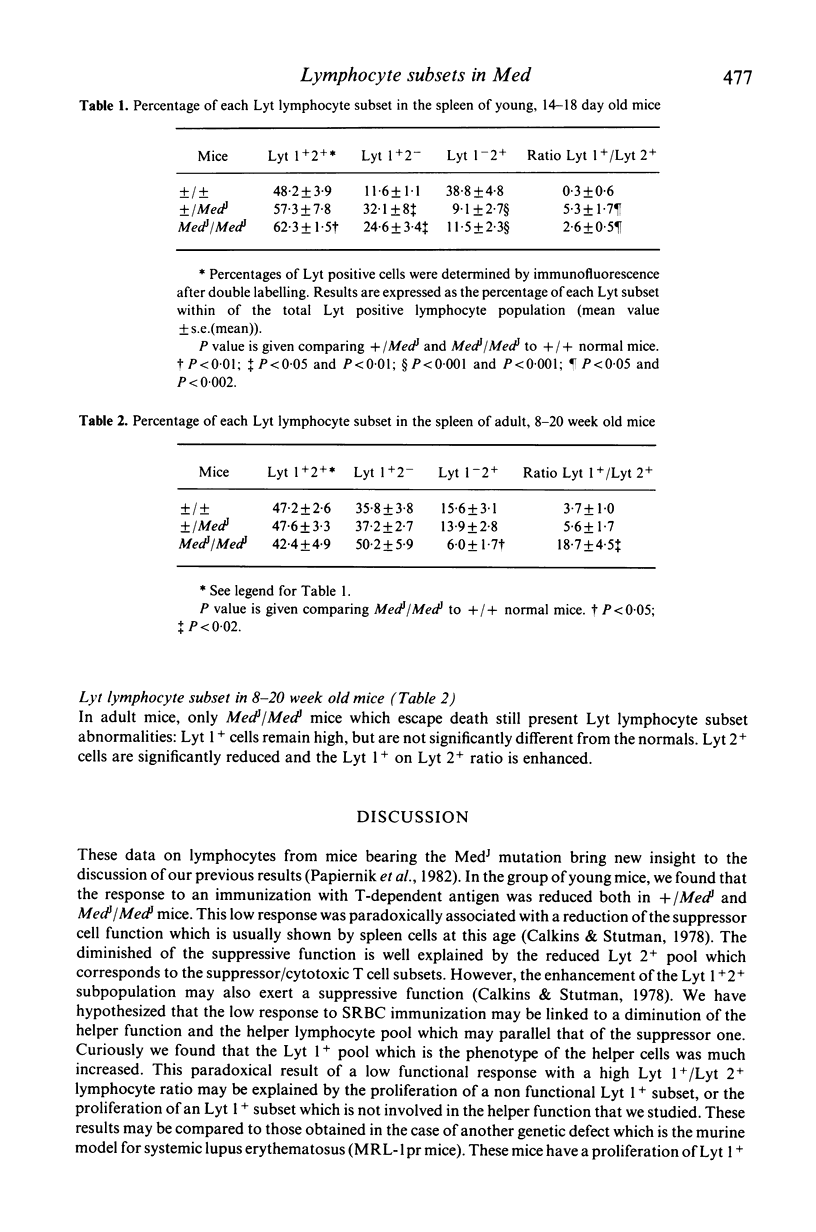Abstract
Motor end-plate disease (Med) in mice is associated with complex immunological abnormalities which are shared by the heterozygous +/MedJ mice, which exhibit no or mild clinical manifestations, and by MedJ/MedJ mice which die from this neuromuscular disorder. In the present paper we extend our immunological data with the study of splenic lymphocyte subsets with Lyt monoclonal antibodies. Both MedJ/MedJ and +/MedJ 14-18 day old mice have high Lyt1+/Lyt2+ ratios, with higher Lyt1+ and reduced Lyt2+ lymphocyte pools as compared to normal mice. This correlates with the low suppressive function previously described, but is unexpected in view of the low helper function as measured by the response to SRBC immunization. Adult +/MedJ mice recovered normal T lymphocyte subset levels, while the small group of MedJ/MedJ mice that escapes death but continues to suffer from the neuromuscular illness maintains high Lyt1+/Lyt2+ ratios.
Full text
PDF



Selected References
These references are in PubMed. This may not be the complete list of references from this article.
- Bach M. A., Phan-Dinh-Tuy F., Tournier E., Chatenoud L., Bach J. F., Martin C., Degos J. D. Deficit of suppressor T cells in active multiple sclerosis. Lancet. 1980 Dec 6;2(8206):1221–1223. doi: 10.1016/s0140-6736(80)92480-0. [DOI] [PubMed] [Google Scholar]
- Berrih S., Gaud C., Bach M. A., Le Brigand H., Binet J. P., Bach J. F. Evaluation of T cell subsets in myasthenia gravis using anti-T cell monoclonal antibodies. Clin Exp Immunol. 1981 Jul;45(1):1–8. [PMC free article] [PubMed] [Google Scholar]
- Calkins C. E., Stutman O. Changes in suppressor mechanisms during postnatal development in mice. J Exp Med. 1978 Jan 1;147(1):87–97. doi: 10.1084/jem.147.1.87. [DOI] [PMC free article] [PubMed] [Google Scholar]
- Karmali R. A., Horrobin D. F. Abnormalities of thymus growth in dystrophic mice. Nature. 1976 Oct 21;263(5579):684–685. doi: 10.1038/263684a0. [DOI] [PubMed] [Google Scholar]
- Lewis D. E., Giorgi J. V., Warner N. L. Flow cytometry analysis of T cells and continuous T-cell lines from autoimmune MRL/l mice. Nature. 1981 Jan 22;289(5795):298–300. doi: 10.1038/289298a0. [DOI] [PubMed] [Google Scholar]
- Papiernik M., Rieger F., Ezine S., Pincon-Raymond M. Impairment of T lymphocyte functions in mice with motor end-plate disease. Clin Exp Immunol. 1982 May;48(2):429–436. [PMC free article] [PubMed] [Google Scholar]
- Sidman R. L., Cowen J. S., Eicher E. M. Inherited muscle and nerve diseases in mice: a tabulation with commentary. Ann N Y Acad Sci. 1979;317:497–505. doi: 10.1111/j.1749-6632.1979.tb56567.x. [DOI] [PubMed] [Google Scholar]
- Smith K. A. T-cell growth factor. Immunol Rev. 1980;51:337–357. doi: 10.1111/j.1600-065x.1980.tb00327.x. [DOI] [PubMed] [Google Scholar]
- Theofilopoulos A. N., Eisenberg R. A., Bourdon M., Crowell J. S., Jr, Dixon F. J. Distribution of lymphocytes identified by surface markers in murine strains with systemic lupus erythematosus-like syndromes. J Exp Med. 1979 Feb 1;149(2):516–534. doi: 10.1084/jem.149.2.516. [DOI] [PMC free article] [PubMed] [Google Scholar]
- de Kretser T. A., Livett B. G. Evidence of a thymic abnormality in murine muscular dystrophy. Nature. 1976 Oct 21;263(5579):682–684. doi: 10.1038/263682a0. [DOI] [PubMed] [Google Scholar]


